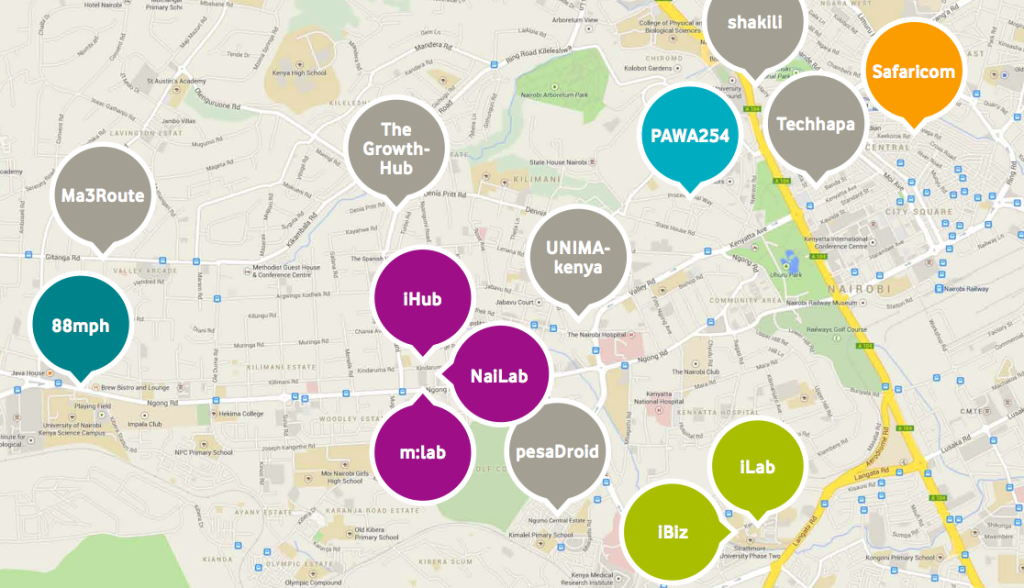“The Emergence, Challenges and Potential of the Kenyan Tech Ecosystem” is a Report by Julia Manske published by the Vodafone Institute. Follow the link above for an overview and a podcast on the topic.
[PDF Download of the “The Emergence, Challenges and Potential of the Kenyan Tech Ecosystem” Report.]

There are a lot of reports that touch on the tech developments in Kenya over the years, but few do as good of a job painting the background picture and how it has taken a few years to develop. Here’s a rather long excerpt, which gives a pretty good 10,000 foot view of the last 4-6 years in the Nairobi tech space:
With the success of M-Pesa Kenya advanced to the position of a global pioneer and international point of reference for mobile payment systems. For the first time Kenya was associated with technology-driven innovation. International media and large companies took notice of the African country. This had an effect on the Kenyans’ self-image. M-Pesa’s success became an identity-forming narrative; the idea that an innovation can come out of Kenya crystallised in the collective memory of the younger generation in particular.
Similar to the butterfly effect,16 M-Pesa became the trigger and driver of a new ecosystem of mobile technological innovations. It created a mood in which resources were pooled and key thinkers from the Kenyan tech and start-up scene got together. This development was accelerated by the foundation of the Ushahidi platform that was set up at the start of 2008 following the uprisings in the context of the Kenyan presidential elec- tions. As a reaction to the violence, an ad hoc team of developers and bloggers came together to collect witness statements via SMS and plot them on a Google map, thereby initiating what is termed “activist mapping”. The free open source service is now used by bloggers and activists across the world, for example for the earthquake at Christchurch or the Gaza war in 2008. The company that came out of this process enjoys high levels of familiarity in Kenya and its founders have become leading digital opinion makers.
One of the Ushahidi founders, the blogger Erik Hersman, was struck by the absence of places to exchange ideas in Kenya and so in 2010 he set up the iHub, one of the first co-working spaces for companies from the tech scene in Africa.
This was followed by a whole host of further technology spaces, incubators and accelerators. The Bishop Magua Centre, the fourth floor of which is occupied by the iHub, is also home to the spin-offs iHub Research, the iHub UX Lab, the start-ups Ushahidi, mFarm, Frontline SMS, mLab, the accelerator Nailab, Kopo Kopo, Preakelt and the Africa office of GSMA. The Who’s Who of the Kenyan tech scene is housed in a single building. Other actors such as the accelerators 88mph and The Growth Hub have set up shop in the immediate vicinity. Large multinational companies such as Google, Microsoft, GSMA, Nokia and IBM have opened branches and research centres. This development is facilitated by a liberal economic system with a dynamic and strong private sector that promotes efficiency, competition and overseas investments. Within seven years Nairobi has developed into an African centre of technological innovations – journalists dub it “Silicon Savannah”.
The success story of Kenya also radiated to other African countries. Technology experts, developers and designers started cooperating and by doing so gave rise to the technological ecosystem that they had been missing until that point. Especially Ghana, Nigeria, Rwanda, Ethiopia and South Africa saw similar developments as in Kenya. Large development organisations, such as InfoDev which is associated with the World Bank, setup co-working spaces and accelerators. Microsoft, Google and individual investors financed the expansion of a range of start-up centres in the African metropolises. Spread across the continent there are now over 35 locations for tech innovations in 13 African countries – of which many are members of the AfriLabs [www.afrilabs.com] alliance. These generate new inventions and mobile and digital business ideas every year.
It’s a good report, worth a read and it covers a lot besides this, including a recipe for creating a tech ecosystem:
- Create access to funding capital
- Promote lasting structures
- Establish competences
- Set up stable real and virtual networks